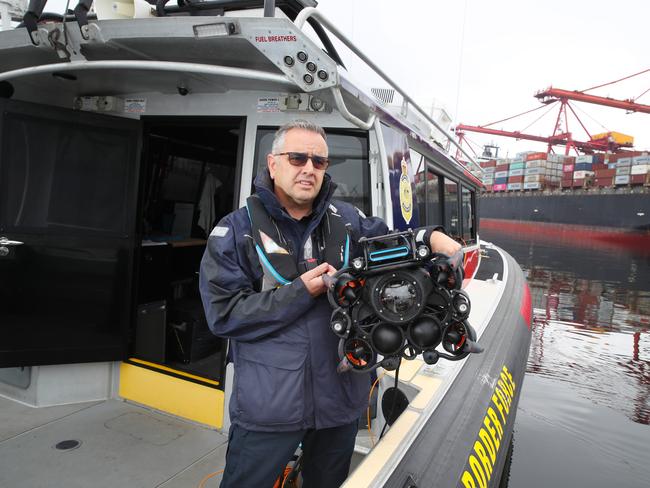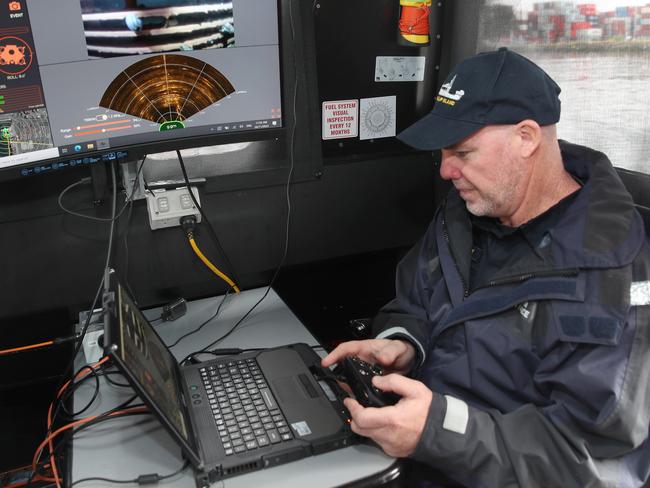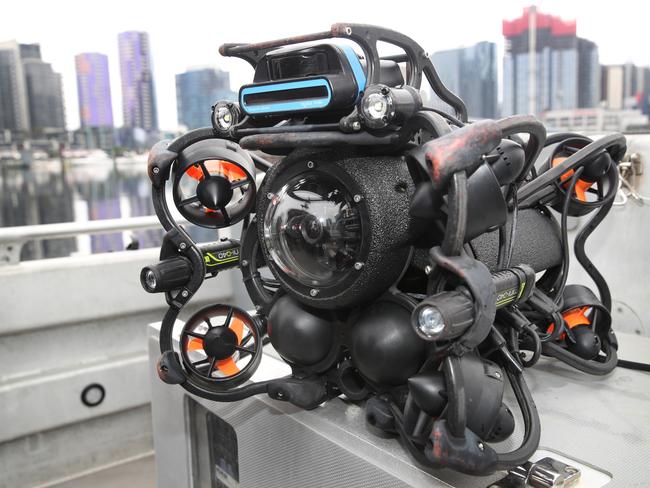Hi-tech underwater devices are the latest weapon busting drugs hidden under ships
A fleet of hi-tech remote controlled devices are the latest weapons being used to uncover drugs hidden under ship hulls coming into Melbourne. Take a look at them in action.
Police & Courts
Don't miss out on the headlines from Police & Courts. Followed categories will be added to My News.
Authorities are cracking down on “parasite smuggling” crime gangs with a fleet of hi-tech devices that have uncovered hundreds of kilograms of drugs hidden under ship hulls.
In the past year alone, Australian Border Force officials in Melbourne have used a remotely controlled search device fitted with sonar technology to conduct more than 200 underwater inspections of ships coming into Australia in a bid to locate huge drug hauls.
Controlled with an Xbox remote, operators steer the device, known as a ROV, from a boat that remains stationed up to 200m away from other ships as they use the underwater camera to search the vessel’s hull and sea chests, an open area where water is pumped in and out of ballast tanks.
Just last week, the technology helped to uncover 154kg of drugs with a street value of $61m inside the hull of a cargo ship that docked at Appleton Dock in the Port of Melbourne.


Officials seized a 200kg cocaine stash from under a boat that arrived at the Maribyrnong Terminal from Brazil in September.
ABF officer Shane Morton said the ROV allowed authorities to search up to four vessels a day without divers needing to enter the water until drugs are discovered.
“It allows us to see in zero visibility and highlights the features of the hull,” Mr Morton said.
“Once we get within a metre, that’s when we generally get normal visibility with the camera.
“The gate to the sea chest swings open and they (criminals) stuff in a package of drugs.”
Mr Morton said criminals were quickly finding more lucrative ways to conceal drug shipments, but state-of-the-art ROVs meant authorities could more thoroughly monitor imports along Australia’s coastline.
“What we’ve found is that overseas cartels have been using those (sea chests) to import drugs into Australia,” he said.
“You get free transport all over the world. Often we see them deploying drug concealments that are also attached with devices like air tags or off the shelf that are tracking devices so they can monitor the location of their shipment in the vessel at any time.”


ABF Commander Clint Sims said criminals went to “extreme”, and sometimes deadly, lengths to hide drugs in a vessel’s sea chests.
It is common practice for syndicates to offer large sums of cash to inexperienced divers to dive under ships and retrieve the hidden shipments.
“It’s not done without any significant risk,” he said.
“There’s extreme risk for the individuals themselves who are retrieving the drugs. It’s an extremely dangerous area to operate.”
Divers risk swimming too close to a boat’s engine turbines, being swept up in harsh currents or becoming stuck between a vessel and the wharf while underwater.
In November last year, scuba diver Bruno Borges Martins died while trying to retrieve a $20m cocaine haul in Newcastle.
Mr Sims said smugglers not only hid drugs underneath ships or hijacked legitimate machinery shipments on board to conceal them, but attached “parasitic” parcels to a vessel that divers could remove upon the ship’s arrival in Australia.
Mr Morton said criminals being willing to undertake such risky tasks to recover dozens of kilograms of drugs at a time showed how much syndicates stood to profit off Australia’s ever-growing appetite for meth and cocaine.
“It’s a lot about the demand that Australia has for illicit drugs,” he said.
“Because of that demand, we see particularly high prices in this region. Because of those high prices that people pay for illicit drugs, we see transnational, serious crime groups that are prepared to put themselves at risk because of the rewards that are potentially on offer.”
Recent analysis of wastewater catchments around Australia found that cocaine and meth consumption were at their highest levels since 2020.
Australian Criminal Intelligence Commission data showed Victorians were the biggest consumers of methamphetamine, heroin and ketamine, and were the second highest users of cocaine.





